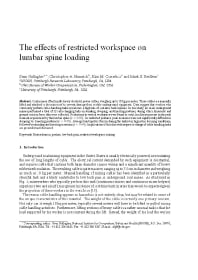Mining Publication: The Effects of Restricted Workspace on Lumbar Spine Loading
Original creation date: March 2001
Authors: S Gallagher, CA Hamrick, KM Cornelius, MS Redfern
Coal miners often handle heavy electrical power cables, weighing up to 10 kg per meter. These cables are manually lifted and attached to the mine roof to prevent damage from mobile underground equipment. Data suggest that workers who commonly perform cable-handling tasks experience a high rate of lost-time back injuries. In this study, six male underground miners performed a total of 12 cable-hanging tasks in standing, stooping, and kneeling postures, during which kinematic and ground reaction force data were collected. Reductions in vertical workspace were found to result in a linear increase in the peak moment experienced by the lumbar spine (p < 0.05). In restricted postures, peak moments were not significantly different in stooping vs. kneeling postures (p > 0.05). Average lumbopelvic flexion during the tasks was highest in stooping conditions, followed by standing and kneeling exertions (p < 0.05). Implications of this data with respect to design of cable handling tasks are presented and discussed.

- Application of Extreme Power Line Communication Methods to Mine Environments
- Characteristics of Gait in Restricted Vertical Space Versus Unrestricted Walking
- Derating Factors for Round and Flat Mine Trailing Cables
- Effects of Posture on Back Strength and Lifting Capacity
- Lifting in Stooped and Kneeling Postures: Effects on Lifting Capacity, Metabolic Cost, and Electromyography of Eight Trunk Muscles
- Locomotion in Restricted space: Kinematic and Electromyographic Analysis of Stoopwalking and Crawling
- Pressure Distribution on the Anatomic Landmarks of the Knee and the Effect of Kneepads
- Solutions to Prevent Materials-Handling Injuries in Underground Coal Mines
- Trunk Extension Strength and Muscle Activity in Standing and Kneeling Postures
- Working in Unusual or Restricted Postures